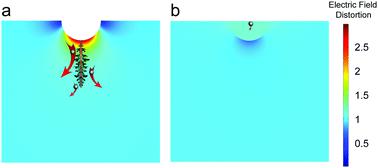当前位置:
X-MOL 学术
›
Energy Environ. Sci.
›
论文详情
Our official English website, www.x-mol.net, welcomes your
feedback! (Note: you will need to create a separate account there.)
All-organic dielectric polymer films exhibiting superior electric breakdown strength and discharged energy density by adjusting the electrode–dielectric interface with an organic nano-interlayer
Energy & Environmental Science ( IF 32.4 ) Pub Date : 2021-08-25 , DOI: 10.1039/d1ee01960k Jia-Yao Pei 1 , Shao-Long Zhong 1 , Yu Zhao 2 , Li-Juan Yin 1 , Qi-Kun Feng 1 , Lei Huang 1 , Di-Fan Liu 1 , Yong-Xin Zhang 1 , Zhi-Min Dang 1
Energy & Environmental Science ( IF 32.4 ) Pub Date : 2021-08-25 , DOI: 10.1039/d1ee01960k Jia-Yao Pei 1 , Shao-Long Zhong 1 , Yu Zhao 2 , Li-Juan Yin 1 , Qi-Kun Feng 1 , Lei Huang 1 , Di-Fan Liu 1 , Yong-Xin Zhang 1 , Zhi-Min Dang 1
Affiliation

|
Polymer dielectrics for energy storage applications usually endure high electric field strength. Adjustment of the composition and structure of the dielectric bulk phase to enhance the dielectric breakdown strength has been widely studied. However, the effect of electrode–dielectric interface on the breakdown strength has received little attention, which greatly hinders further development in this field. In this work, an all-organic double-layer dielectric film consisting of poly(vinylidene fluoride) (PVDF) as the matrix and polymethyl methacrylate (PMMA) as the organic nano-interlayer was prepared. By adjusting the electrode–dielectric interface, remarkably improved electric breakdown strength (767.05 MV m−1) and discharged energy density (19.08 J cm−3) were realized concurrently without sacrificing the charge–discharge efficiency. The experimental results and computational simulations reveal that the surface morphology of dielectrics has a great effect on the electric field distribution at the electrode–dielectric interface, and further affects the leakage current and breakdown strength of the dielectric. The PMMA nano-interlayer modifies the surface defects and increases the Young's modulus at the electrode–dielectric interface, leading to the improvement of insulation performance. These findings offer a new perspective to understand the impact of the electrode–dielectric interface on the polymer dielectric breakdown strength. This work provides a novel paradigm for fabricating polymer dielectrics with high breakdown strength for energy storage.
中文翻译:

通过用有机纳米夹层调整电极 - 介电界面,全有机介电聚合物薄膜表现出优异的电击穿强度和放电能量密度
用于储能应用的聚合物电介质通常能承受高电场强度。已经广泛研究了调节介电体相的组成和结构以提高介电击穿强度。然而,电极-电介质界面对击穿强度的影响很少受到关注,这极大地阻碍了该领域的进一步发展。在这项工作中,制备了由聚偏二氟乙烯(PVDF)作为基质和聚甲基丙烯酸甲酯(PMMA)作为有机纳米夹层的全有机双层介电薄膜。通过调整电极-电介质界面,显着提高了电击穿强度(767.05 MV m -1)和放电能量密度(19.08 J cm -3) 是同时实现的,而不会牺牲充放电效率。实验结果和计算模拟表明,电介质的表面形貌对电极-电介质界面处的电场分布有很大影响,进而影响电介质的漏电流和击穿强度。PMMA纳米夹层修饰了表面缺陷并增加了电极-电介质界面的杨氏模量,从而提高了绝缘性能。这些发现为理解电极-电介质界面对聚合物介电击穿强度的影响提供了新的视角。这项工作为制造具有高击穿强度的聚合物电介质用于储能提供了一种新的范例。
更新日期:2021-09-13
中文翻译:

通过用有机纳米夹层调整电极 - 介电界面,全有机介电聚合物薄膜表现出优异的电击穿强度和放电能量密度
用于储能应用的聚合物电介质通常能承受高电场强度。已经广泛研究了调节介电体相的组成和结构以提高介电击穿强度。然而,电极-电介质界面对击穿强度的影响很少受到关注,这极大地阻碍了该领域的进一步发展。在这项工作中,制备了由聚偏二氟乙烯(PVDF)作为基质和聚甲基丙烯酸甲酯(PMMA)作为有机纳米夹层的全有机双层介电薄膜。通过调整电极-电介质界面,显着提高了电击穿强度(767.05 MV m -1)和放电能量密度(19.08 J cm -3) 是同时实现的,而不会牺牲充放电效率。实验结果和计算模拟表明,电介质的表面形貌对电极-电介质界面处的电场分布有很大影响,进而影响电介质的漏电流和击穿强度。PMMA纳米夹层修饰了表面缺陷并增加了电极-电介质界面的杨氏模量,从而提高了绝缘性能。这些发现为理解电极-电介质界面对聚合物介电击穿强度的影响提供了新的视角。这项工作为制造具有高击穿强度的聚合物电介质用于储能提供了一种新的范例。











































 京公网安备 11010802027423号
京公网安备 11010802027423号